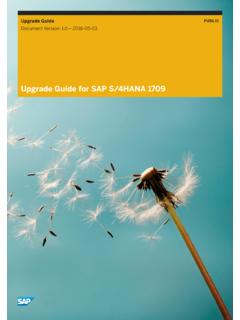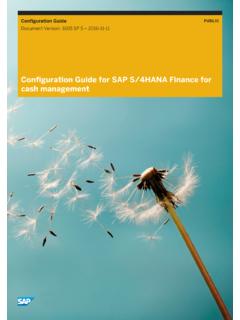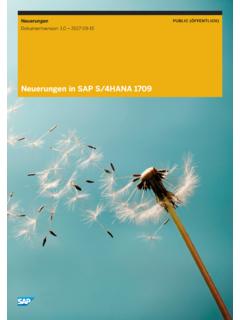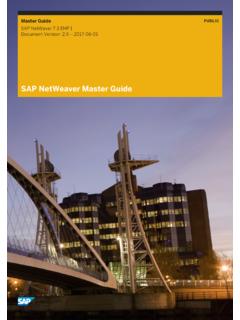Transcription of SAP HANA Core Data Services (CDS) Reference
1 PUBLICSAP hana Platform SPS 00 Document Version: 2016-11-30 SAP hana core data Services (CDS) ReferenceContent1 Introduction to SAP hana core data Services ..52 Getting Started with core data Developing Native SAP hana Roles and Permissions for XS Setting up the data Persistence Model in SAP Developer Information hana Developer Information by hana Developer Information by hana Developer Information by Creating the Persistence Model in core data CDS Text Create a CDS Artifacts in Naming Comment Create an Entity in Element Entity Syntax Migrate an Entity from hdbtable to CDS (hdbdd).
2 77 Migration Guidelines: hdbtable to CDS hana to CDS data -Type Create a User-Defined Structured Type in User-Defined data Structured Type Structured Primitive data Create an Association in Association Syntax hana core data Services (CDS) Create a View in View Syntax Types and Modifications to CDS Tutorial: Get Started with Import data with CDS Provisioning Using Table Configuration-File Configuration Error Creating the data Persistence Artifacts in XS Create the data Persistence Artifacts in XS Database Resources in XS Design-Time Resources and Build Create a CDS Document (XS Advanced).
3 164 CDS Documents in XS CDS Artifacts in XS Naming CDS Metadata in Catalog Reader API for Contexts in XS Comment Extensions Create a CDS Access-Policy Document (XS Advanced)..195 CDS Access Policies in XS Create a CDS Aspect (XS Advanced).. Create a CDS Role (XS Advanced)..201 CDS Role Syntax Create a CDS Entity in XS Entities in XS Element Entity Syntax Options in XS Create a CDS User-Defined Structure in XS User-Defined data Types in XS Structured Type Definition in XS Structured Types in XS Primitive data Create a CDS Association in XS hana core data Services (CDS)
4 ReferenceContentPUBLIC3 CDS Association Syntax Create a CDS View in XS View Syntax Types and Create a CDS CDS Extension CDS Extension Descriptor CDS Extension Package CDS Extension Package Descriptor hana core data Services (CDS) ReferenceContent1 Introduction to SAP hana core data Services This guide explains how to use core data Services (CDS) to build design-time data -persistence models in SAP hana Extended Application Services (SAP hana XS) - for both XS classic and XS advanced models. The data -persistence model is used to define the data to expose in response to client requests via HTTP, for example, from an SAPUI5-based information in this guide is intended primarily for application and database developers and focuses on the tasks the application and database developers most commonly need to perform when designing and creating the data model, for example, creating tables, views.
5 However, the SAP hana core data Services (CDS) Reference also includes additional information, too, for example, Reference and conceptual. TasksStep-by-step instructions that show how to create the most important and commonly used database artifacts Reference materialDetailed descriptions of the syntax required to define data artifacts along with code examples and illustrations Background conceptsExplanations of the underlying concepts on which the various CDS design-time database artifacts types are basedDue to incompatible differences between the CDS syntax supported by SAP hana XS Classic and SAP hana XS Advanced, the guide is split into the following sections.
6 Defining data models in XS classicDefining the data model, managing the data model in the SAP hana repository, activating the data model and managing the resulting objects in the database catalog, and consuming the data model (for example, in a client UI) Defining data models in XS advancedDefining the data model, setting up the SAP hana deployment infrastructure (HDI), deploying the data model, and consuming the data model (for example, in a client UI)Related InformationGetting Started with core data Services [page 6]Creating the Persistence Model in core data Services [page 29]Creating the data Persistence Artifacts in XS Advanced [page 156]SAP hana core data Services (CDS) ReferenceIntroduction to SAP hana core data Services PUBLIC52 Getting Started with core data ServicesCore data Services (CDS) is an infrastructure that can be used by database developers to create the underlying (persistent)
7 data model which the application Services expose to UI database developer defines the data -persistence and analytic models that are used to expose data in response to client requests via HTTP. With CDS, you can define a persistence model that includes objects such as tables, views, and structured types; the database objects specify what data to make accessible for consumption by applications and how. This guide takes you through the tasks required to create CDS documents that define the objects most often used in a data persistence model, for example: Create a table (entity) Create an SQL views Create an association between entities or views Create a user-defined structured typeThe SAP hana core data Services (CDS) Reference also provides code examples that illustrate how to specify the various object types.
8 In addition, the CDS Reference also includes the complete specification of the CDS syntax required for each object the data model is the first step in the overall process of developing applications that provide access to the SAP hana database. When you have created the underlying data persistence model, application developers can build the application Services that expose selected elements of the data model to client application by means of so-called data end-points . The client applications bind UI controls such as buttons or charts and graphs to the application Services which in turn retrieve and display the requested you can start using CDS to define the objects that comprise your persistence model, you need to ensure that the following prerequisites are met: You must have access to an SAP hana system.
9 You must have already created a development workspace and a project. You must have shared a project for the CDS artifacts so that the newly created files can be committed to (and synchronized with) the repository. You must have created a schema for the CDS catalog objects created when the CDS document is activated in the repository, for example, MYSCHEMANoteIt is not possible to use the CDS syntax to define a design-time representation of a database schema. The owner of the schema must have SELECT privileges in the schema to be able to see the generated catalog hana core data Services (CDS)
10 ReferenceGetting Started with core data ServicesRelated InformationSetting up the data Persistence Model in SAP hana [page 11]Roles and Permissions for XS Development [page 9] Developing Native SAP hana ApplicationsIn SAP hana , native applications use the technology and Services provided by the integrated SAP hana XS term native application refers to a scenario where applications are developed in the design-time environment provided by SAP hana extended application Services (SAP hana XS) and use the integrated SAP hana XS platform illustrated in the following program that consists purely of SQLS cript is also considered a native SAP hana server-centric approach to native application development envisaged for SAP hana assumes the following high-level scenario.









